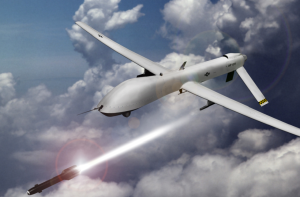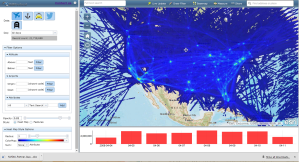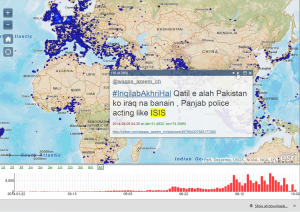
GPU-Powered Terrorist Hunter Eyes Commercial Big Data Role

A company called GIS Federal that’s helping the U.S. Army track the movement of terrorists across time, space, and the Internet using a distributed, GPU-powered, in-memory database is gearing up to head out into the commercial world and help private companies track the movements of physical and virtual assets in powerful new ways.
GIS Federal is a technology startup based in Virginia that has been incubated by the U.S. Army. The company works closely with the U.S. Army’s Cyber Center of Excellence in Fort Gordon, where the government uses the company’s GPU-powered database, dubbed GPUdb, to track terrorist movements around the world.
“Our mission in the military is to kill or capture terrorists. We’re basically the big data computational engine that does that,” says Amit Vij, CEO of GIS Federal. “We fuse the UAV [unmanned aerial vehicle] data, the track data, with signal intelligence. With those two data feeds combined, we can come up with a high probability of the location of where somebody would be.”
During a demo by Vij last week, GPUdb plotted millions of recorded plane and ship movements, which are publicly available data sources–the data collected by the government’s UAVs (i.e. “drones”) is highly classified. The software lets the user scroll down and view the metadata associated with each individual plane or ship. Users can zoom into specific areas, and use filters to view only specific object types in a given area, such as tankers in the Marjan oil field.
The software also tracks velocity and object types. You can tell the software to show all white SUVs in a given area that are traveling between 20 and 40 miles per hour. (That might have helped to find O.J. But then again, the helicopters were a dead giveaway.)
For fun, Vij pointed the Twitter fire hose at GPUdb and started drawing random polygons around entire regions of the U.S. The software responded by picking up only the tweets in those areas that have the appropriate hashing. This might not be the best way to see what’s trending around the Great Lakes, but it does show how well GPUdb works on big, fast, and diverse data sets.
Massively Multicore and Distributed
GPUdb contains several elements that make it unique in the big data analytics space. For starters, it’s designed to run on GPUs, such as Nvidia Tesla and Intel Phi, which are much faster than regular X86 at certain types of mathematically intensive workloads. Secondly, the GPUdb database is distributed, which means users can string together multiple GPUs to boost the processing power; other GPU-optimized databases are not distributed, GISFederal says.
The company also touts a feature of GPUdb that it calls “query chaining,” which refers to the capability to layer multiple queries together. Lastly, the database has native support for geospatial objects, as well as the capability to quickly render those objects on a screen, via a simple JavaScript API.
“That’s the big difference between us and every other database in the world–we actually have a distributed rendering system built in,” says GIS Federal CTO Nima Negahban. “You’re not sending all that data to the client device for them to render it, so you can view billions of data points on a phone, or on any kind of thin device, because all its showing is a 200kb PNG.”
GIS Federal says the combination of these elements give GPUdb the capability to do things that no other databases can do–not even SAP HANA, Oracle TimesTen, or IBM Netezza equipped with FGPAs. “We laugh at Oracle or HANA, because they can’t scale like we can,” Vij says. “Our roadmap is we’re going to be taking the Oracle math and SAP math functions, GPU-accelerating them, and crushing their numbers. If that data had geospatial data or anything that be visualized…we can create that on the fly. No other database does that right now.”
Real World Applications
While the military may be using GPUdb to find and track terrorists, GIS Federal envisions the software finding a home in the civilian sector too. The software’s built-in support for geospatial objects makes it a natural for tracking physical assets like airplanes, trucks, and ships. Similarly, its capability to handle high volume and high velocity data will open up use cases in social media, telecommunications, and logistics.
One early adopter in the commercial sector is a large national logistics company, which is using it do route optimization by doing anomaly detection. Another account has GIS Federal working with SGI to process data gathered from a fleet of unmanned vehicles (UVs).
“If a customer has assets that move over space and time and they want to be able to do fine-grained analysis over that and correlate it to other business statistics, then they’ll be able to do much more with GPUdb than any oth er database,” Negahban says. “The application isn’t tuned for specific use cases. But because we have so much processing and visualization capability, it quickly become a powerful tool for a lot of segments.”
er database,” Negahban says. “The application isn’t tuned for specific use cases. But because we have so much processing and visualization capability, it quickly become a powerful tool for a lot of segments.”
GIS Federal’s roadmap calls for more machine learning and predictive analytics capabilities in GPUdb. It’s also wants GPUdb to become more of an open framework for other developers to build more specialized capabilities. The 35-peson company is also looking to bolster its market presence, which is what drew executives out to Silicon Valley for a recent IDC event.
While they have yet to break into the mainstream of the big data analytics industry, GPUs are on the cusp of achieving big things. Companies like GIS Federal are poised to lead the way–not if GPUs arrive at the tipping point, but when.
Related Items:
MIT Spinout Exploits GPU Memory for Vast Visualization
Ersatz Thinks Up a GPU-Powered Neural Network
GPU-Powered Tagging Service ‘Gets’ the Big Picture





























